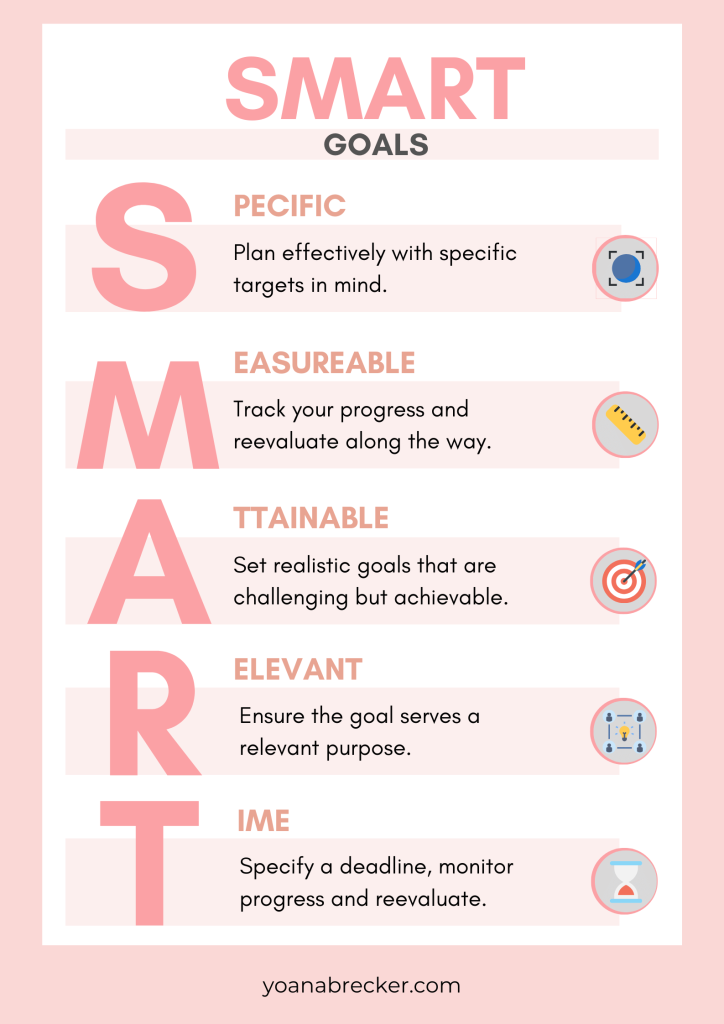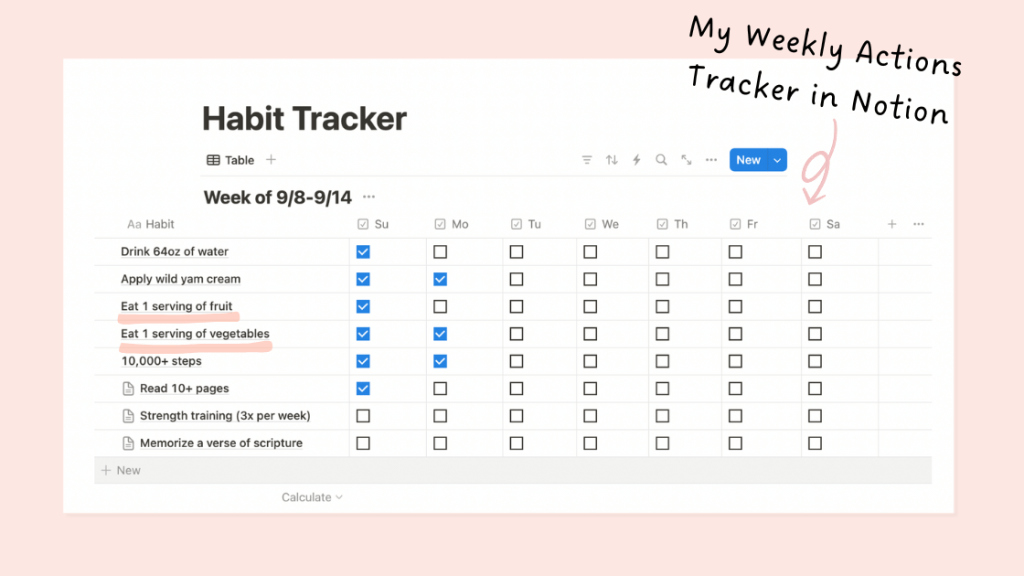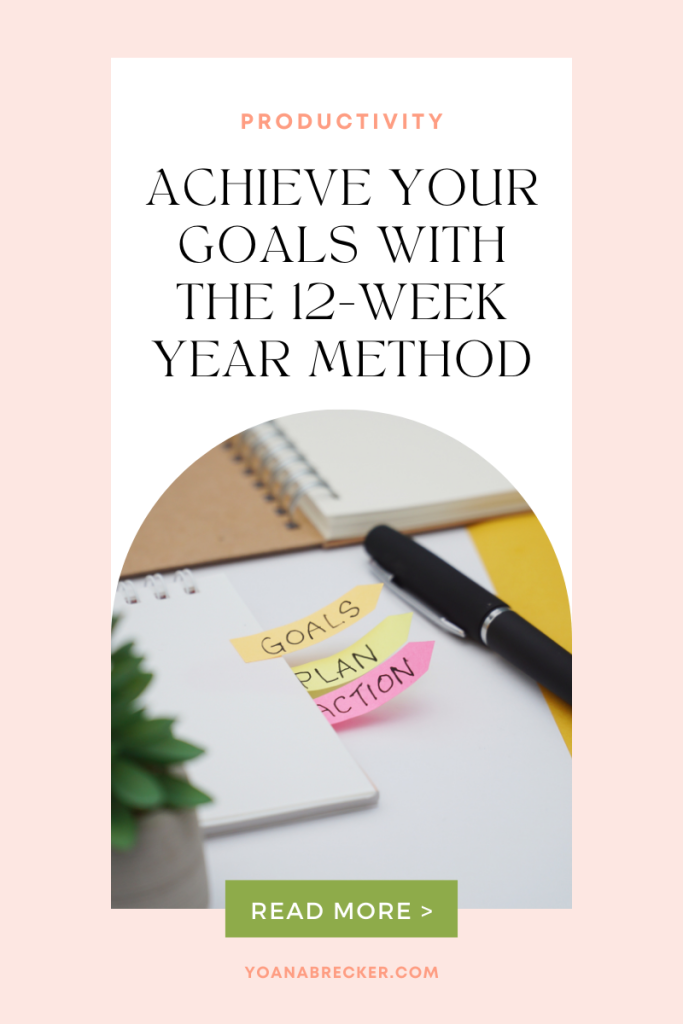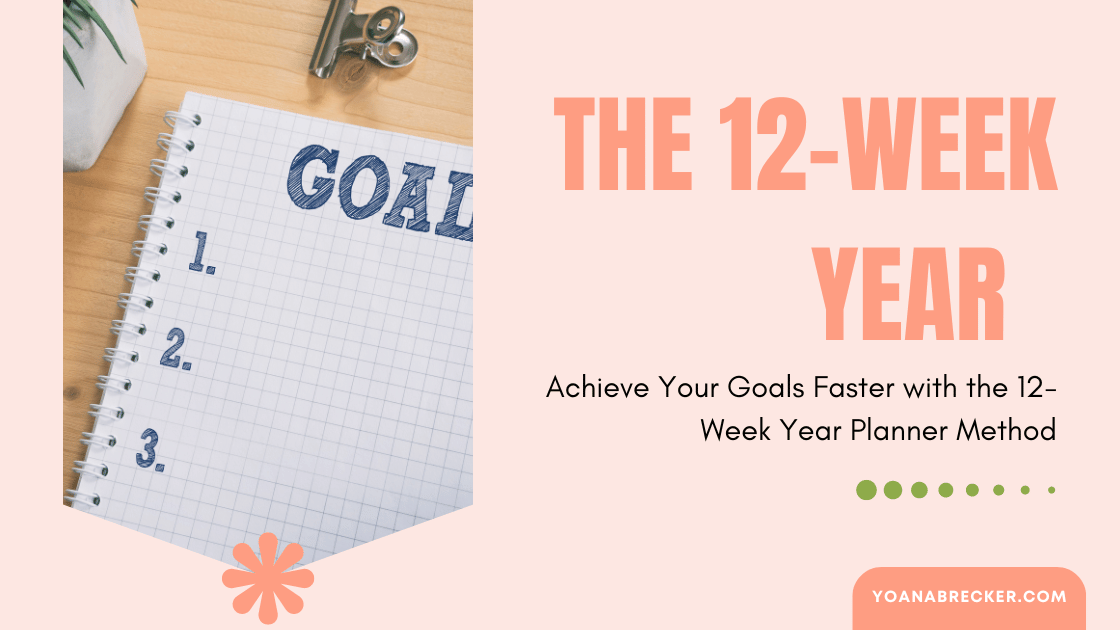Sometimes, achieving our goals takes a backseat because they feel overwhelming and unattainable.
Today, I will tell you about a goal-setting method I love and implemented into my life. It’s called the 12-week year method; you may have already heard about it.
The 12-Week Year is a book by Brian P. Moran and Michael Lennington. In it, they explain the 12-week year method of achieving goals. I highly recommend you read it. You can get the book online or borrow it from your local library. Their innovative method breaks down a year’s worth of goals into a 12-week period, making ambitious goals more manageable and attainable. By adopting this revolutionary framework, you shrink your mental timelines, creating urgency, improving focus, and significantly boosting your productivity!
Step-by-Step Guide to the 12-Week Year Process
I’ll walk you through using the 12-Week-Year Process. We will use one of the goals I’m working on now so you can see how easy it is to implement.
Step 1: Create SMART Goals With a 12-week Deadline
Write down your goals using the SMART goals framework, but with a twist—set a 12-week deadline. Remember, these goals should be:
- Specific: Clearly define what you want to achieve.
- Measurable: Ensure your goal is quantifiable.
- Achievable: Set realistic objectives that you can attain.
- Relevant: Make sure your goal aligns with your broader life objectives.
- Time-bound: Set a deadline within the 12 weeks.

Example: My big goal is to lose 35 lbs.
(Health professionals recommend safely losing 1-2 lbs per week. I picked 1.5 lbs for 12 weeks, so it’s right in the middle. 1.5 lbs for 12 weeks is a total of 18 lbs lost.)
My 12-week SMART goal is to Lose 18 lbs by Nov 30, 2024 (12 weeks from the date I started).
Step 2: Pick your weekly tactics/actions.
Brainstorm a list of actions that will get you to your goal. Some may be one-time actions, and others must happen weekly or daily.
Example: My daily actions are
- Eat 2-3 meals per day
- Wait a minimum of 5 hours between meals
- Eat my last meal by 6 pm (preferably a light meal)
- Eat at least one serving of fruit per day
- Eat at least one serving of veggies per day
- Wherever possible, choose plant-based ingredients (no dairy/meat).
- Weigh in once a week
Step 3: Choose Your Reward
Setting a reward for achieving your goals, no matter how small, can help you maintain motivation and momentum. Rewards provide a sense of accomplishment and can make working toward a goal more enjoyable. Even a small reward can serve as a positive reinforcement, reminding us of our progress and encouraging us to continue striving for success.
Example: Once I’ve accomplished my goal of losing 18lbs, I will schedule a massage.
Step 4: Weekly Check-ins Using a Tracker
Now that the goal is written down, you’ve got your actions and rewards; the next step is setting up a system to help keep yourself accountable. The author recommends tracking your actions and weekly check-ins. He provides a free PDF you can download and other free resources on his website.
Schedule time for yourself to have this check-in and analyze your progress. Get it on your calendar!
You can use a digital planner or a digital tool like Notion, which I use. You can create a simple habit tracker to monitor your progress towards your leading indicators (more on that below). Reflect on your week—what went well, what could be improved, and how you can adapt your actions to align closer with your goals. If you want my template, I’m happy to share it, but it’s pretty easy to create in Notion.

Example: Every Sunday morning (my daughter and I go to a local cafe for a couple of hours every Sunday), I review my habit tracker for the previous week and analyze my progress. This is also the day I plan to weigh in.
Understanding Leading vs. Lagging Indicators
I loved learning about the distinction between leading and lagging indicators. You cannot influence lagging indicators directly—they are the outcomes of your efforts. Leading indicators are within your control and directly impact your ability to reach your goals. These include the habits and tasks you can perform daily or weekly.
My lagging indicator is the number on the scale; I can’t control what the number says, but my leading indicators are the activities I can control, like not snacking between meals, eating my fruits and vegetables, and not eating late at night personally because it doesn’t make me feel good and keeps me from getting good sleep, and that doesn’t contribute to my goal. Focusing on these leading indicators gives me control and empowerment over my progress.
I don’t worry about the number on the scale; in fact, I put my scale away so I focus on my habits and actions instead. Sometimes, when I look at the scale every morning, I get discouraged and feel like giving up.
Now, I focus on my actions. These tactics and my weekly check-in help keep my motivation high. I regularly check in and assess my goals instead of giving myself a year to waste and wait around. Plus, I love that I planned a reward for this 12-week stretch instead of waiting to reward myself once I reach my total weight loss goal.
Other goal-setting methods used to overwhelm me because I was trying to accomplish such a big goal without breaking it into more manageable and realistic chunks. But with the 12-Week Year method, I felt a sense of relief and empowerment as I could now tackle my goals in a more controlled and manageable way.
Start Today!
The beauty of the 12-week year lies in its simplicity and the immediate feedback loop from your efforts. By emphasizing actions you can control, scheduling regular check-ins, and rewarding yourself for hitting your 12-week targets, you harness the power of short-term goals to create long-term successes. So, why wait? Start your 12-week Year journey today and feel the motivation and readiness to take action.
Break down a big goal into a manageable 12-week plan and discover how successful you can be. Remember, the journey of a thousand miles begins with a single step—or, in this case, a well-planned 12 weeks. Embrace this opportunity to revolutionize the way you set and achieve your goals.
P.S. I recommend you watch this super thorough video on incorporating the 12-week year method. I found it so helpful and encouraging. She explains everything very well!



